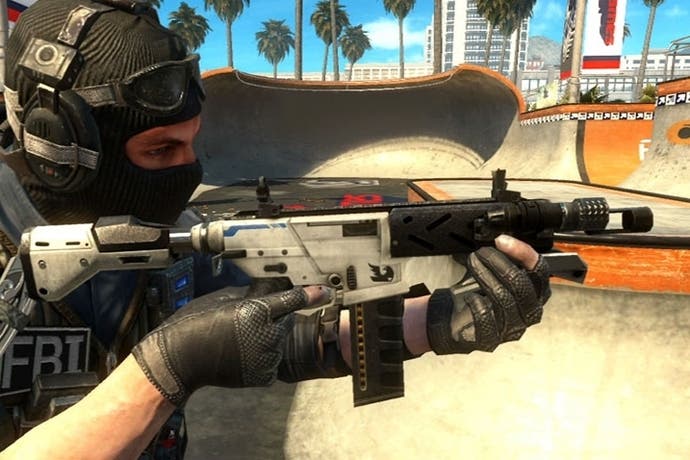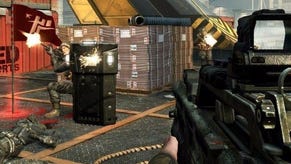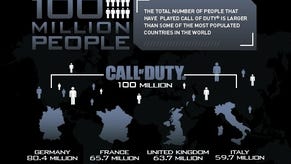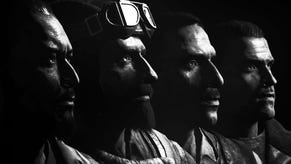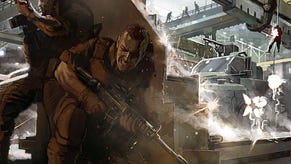Call of Duty: Black Ops 2 - Revolution review
First against the wall?
Revolution is a loaded word to throw around, particularly when connected to a series widely - and sometimes wrongly - perceived to be stuck in its ways. Black Ops 2 made a surprisingly successful effort to shake up the Call of Duty formula, adding branching narrative threads and custom loadouts to its bombastic campaign corridors, but despite the name that experimental urge doesn't quite make its presence felt in the first batch of premium priced DLC.
Revolution is a peculiar finger buffet of content, containing four multiplayer maps, a new Zombies map, a new Zombies game mode and one new weapon - the first DLC weapon in the series.
That aspect has caused some consternation among fans, but despite some impressive stats the Peacekeeper is not a gamebreaker. Combining the best features of an SMG with the range and punch of an assault rifle, it's an incredibly handy piece of kit but it won't be replacing the painstakingly unlocked and customised weapons favoured by the long-serving player. What it does do is offer a more robust starting weapon for new players, and that's a crucial benefit now that the game's player base has had time to cruise past the prestige ranks, and punishing Scorestreak bonuses are rife.
The multiplayer maps will be the main course for most players, and the offering is decent enough. These are good maps, as solidly designed as you'd expect under the Call of Duty banner - and if that sounds like damning them with faint praise, well, that's not inaccurate. There are a couple of interesting flourishes, but those end up feeling more like desperate attempts to add something new rather than a coherent plan for developing the world's top multiplayer game in a new direction.
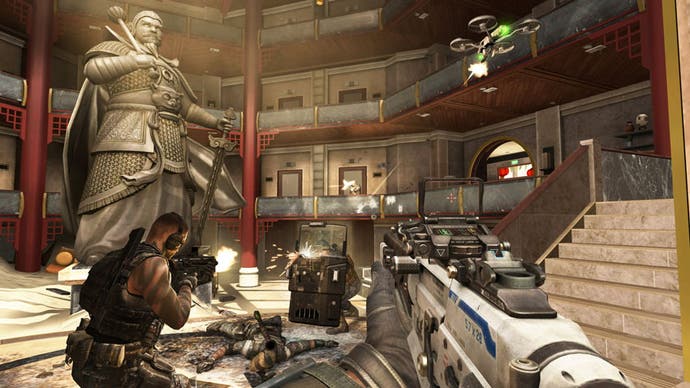
Hydro is typical of this mindset. Based in and around a water treatment plant, it has all the hallmarks of a typical COD map. Tight environments on either side encourage close-quarters play, while an elevated walkway offers a great sniper spot provided you can defend it from both sides. The key feature is the central waterway, which periodically gets flushed out with a torrent of water. That means instant death for any player caught there when the deluge comes.
You get fair warning when a flood is on the way, but it's still an addition that takes player death out of the hands of players, which isn't ideal for a game that has been so ruthlessly balanced and rebalanced in the past. It's one of those ideas that sounds amusing on paper, but ultimately serves to distract from what COD is best at: players shooting each other.
Grind is similar, in the sense that it's an otherwise standard map with a twist. This time it's that you're fighting in a Venice Beach skate park, complete with half pipes, ramps and a skate shop in the middle for your interior shotgunning needs. It's an undeniably appealing location, the bright colours and playful design standing in stark contrast to the severe arenas you expect in a military shooter.
The impact on gameplay is rather subtle though. This is a low, flat map for the most part, full of dips and gulleys. The smooth curved edges of the skate ramps mean that you get an extra few pixels of peripheral vision as enemies approach. What would have been a blind corner is shaved back by a few precious inches, making it a boon to the quick-draw headshot expert. It's no surprise that this is the map that seems to be winning over the majority of Black Ops 2's deathmatch-fixated fanbase.
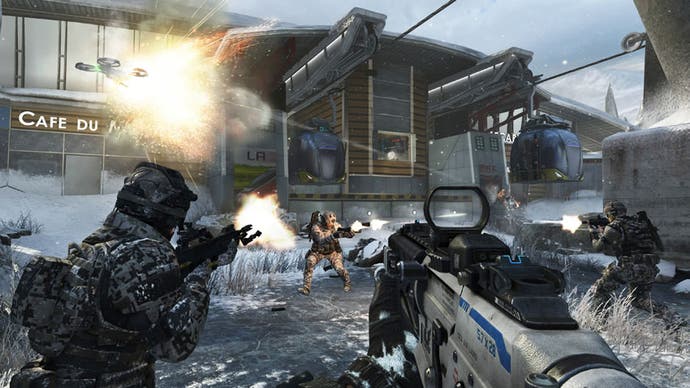
Downhill is a more traditional COD map, bringing a snowy Alpine setting to the playlist. There is a gimmick of sorts - automated cable cars that cut through the central resort building, offering mobile cover and also a good way to get squashed if you're not paying attention - but unlike Hydro and Grind it never feels like the whole map was dictated by this feature.
Once you get outside it's actually - in my apparently outnumbered opinion - the best of the four. It's open without being sparse, with numerous rocks and trees offering natural cover, while long lines of sight make it a more tactical map than the rest. You'll really need to think your way to capture points in Domination matches if you're to avoid exposing yourself to sniper fire while dashing about. Applying just the right amount of brake to COD's hell-for-leather pace, it's a rewarding but sure to be underrated map.
Which just leaves Mirage, set in a ruined hotel on the outskirts of the Gobi desert. Spec Ops: The Line has rather stolen this map's thunder, as the sight of a luxury location half-buried in sand can't help but call to mind 2K's deceptively smart shooter. This one really is a standard COD map, with cover-heavy exteriors looping around murky interiors. You run. You gun. It's perfectly acceptable, but not the sort of map you'll jump to vote for between games.
And that's the problem, minor thought it may be, with this first Black Ops 2 quartet. None of the maps are bad - the machine is too well oiled at this point for that to happen - but none are really stand-out hits either. Grind and Hydro have a certain eye-catching novelty factor, but little to turn them into favourites once you've exhausted their quirks. Downhill and Mirage are both solid, but unspectacular, and likely to be lost in the playlists once all the DLC is released. Taken individually there's little wrong with this selection, but it's a slightly lumpy grab-bag of awkward features and predictable design.

Over on the undead side of the fence, things are even less coherent. All the new Achievements for the Revolution DLC come from playing the new Zombies content, which is strange since it's the section of the COD experience that still feels the most in need of direction.
Die Rise is the new co-op Zombies map and, not unlike Grind and Hydro, it suffers somewhat for being built around a gimmick. The gimmick in this case being a collapsing skyscraper with multiple drops, plunging elevators and disorienting angles. It's not a bad concept for a video game location, of course, but it's not always a good fit with the explore-and-fortify gameplay of Zombies where victory pretty much demands you stay close to other players.
It's a ferociously difficult scenario, and often not in a fun way. It's slow to offer decent weapons and tends to mercilessly spam you with zombies from Round 3 onwards, with many of them clambering or dropping into the play area from spawn points that can't be blockaded. Add in the peril of an unexpected fatal fall - or worse, a non-fatal fall to a floor where your allies can't reach you - and it tests your patience as often as your nerve. For those devoted to this game mode it may well be the brutal next level challenge they need, but to me it merely serves as a reminder that Treyarch has yet to really nail down the core gameplay mechanics of Zombies.
Nowhere is this more evident than in Turned, the new mode in which you can play as a zombie. This is apparently something that fans have clamoured to do, but its implementation here suggests that letting popular opinion dictate your gameplay isn't always the best idea.
A four-player competitive mode, it pits three player-controlled zombies against one human player. As a zombie, you must kill the human, at which point you become the human and start earning points. As the human, you can play with a shotgun as standard, or a reverse Gun Game ruleset where every zombie killed grants you a better weapon.

There's the basics of a decent mode here, but it's just too skittish and frantic to come together. Zombies lurch about at silly speeds, Benny Hill style, and the constant kill-and-respawn mechanic leads to a disorientating rhythm as you find yourself - and your targets - constantly disappearing and popping up somewhere else. It doesn't help that the mode is only playable on the small and claustrophobic Diner map, leading to lots of churning around in a frustratingly small area that leaves the human player's strategic options reduced to little more than "run around in circles and keep shooting".
Throw in a balance-breaking score bonus for the player who just happens to be the human when the timer runs out and you've got a mode that feels like a half-decent idea several drafts away from an actual game. As with so much of COD's Zombies gameplay, there's no getting away from the fact that Left 4 Dead did it first - and did it much better.
There's a lot riding on Revolution. Enormous sales are guaranteed, thanks to the brand, but DLC is now our barometer for where a shooter franchise is headed. Battlefield 3's approach of releasing cohesive themed packs that emphasise and deepen specific styles of play shows that, for all the wobbles the game has suffered, DICE still understands its strengths.
Revolution, on the other hand, feels piecemeal and sometimes even a little desperate, its fractured offering mirroring a franchise now pulling itself in three different directions. The generous conclusion would be that Treyarch is using the DLC to experiment and tweak an established formula. The more cynical approach would be to wonder if uncertainty as to where COD should go next has manifested as maps that rely on gimmicks and game modes that feel like doodles.
Judged purely as a map pack, Revolution does what it needed to do, though it's revealing that the best of the maps - Downhill and Mirage - are the ones that stick so closely to COD formula, and even then fall short of classic "must play" status. Call of Duty devotees will certainly get their play value out of this lucky-dip selection, but it's still slightly disappointing that there's not a more consistent vision for Black Ops 2's long-term future on display. Revolution? Not quite.
